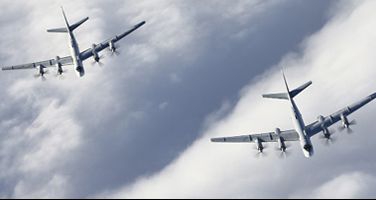The previous day, Thursday 18 September, towards the 01: 30, now Pacific, a pair of Canadian CF-18, intercepted two long-range Russian Bear bombers, about 40 nautical miles off the coast in the Beaufort Sea. In both cases, Russian aircraft entered the Air Defense Identification Zone, which extends approximately 200 miles from the coast. So not just provocations, but actions aimed at monitoring the reaction times of the US Air Defense.
The Russian Navy tested the ballistic missile from 30 Bulava tons, launched by the submarine "Vladimir Monomakh" in military maneuvers in the White Sea, but is only part of the program to modernize the weapon systems. In order to assess the number of missiles, submarines, tanks and various weapons needed by Russia in the 2016-2025 period, Putin signed the decree on the creation of the new Military-Industrial Commission of the Russian Federation. This committee reports directly to the President. This project has a solid financial base; the army has received 2500 billion rubles in the 2000, and will be over 20 billion dollars within the 2020, along with 3 billion dollars allocated separately to military industries.
 The goal is to re-equip the Army, the Navy and modernize the defense industry, as the defensive and offensive system is either exhausted or obsolete. Therefore a program aimed at assessing in a reliable and complete way the potential threats to the military security of the Russian Federation, and as a strong response to the activation of the anti-missile defense system by the United States, developed in Europe and Alaska.
The goal is to re-equip the Army, the Navy and modernize the defense industry, as the defensive and offensive system is either exhausted or obsolete. Therefore a program aimed at assessing in a reliable and complete way the potential threats to the military security of the Russian Federation, and as a strong response to the activation of the anti-missile defense system by the United States, developed in Europe and Alaska.
Mainly it is a contrast to the Prompt Global Strike, studied by the USA, which should destroy all the command centers of the Russian strategic forces. The Russian development of weapons systems is based on high-tech smart systems, which will transform the soldier and officer into arms operators; these systems will be activated remotely by the military operators themselves, far from the combat zone. In fact, it translates into engaging the enemy first, that is, detecting it, intercepting it, following it and destroying it, but without contravening the principle of non-aggression, non-intervention and military self-sufficiency.
The challenge of the Russian government will be to achieve the goal without undermining cooperation with foreign partners, and to stimulate the domestic defense industry, overcoming the sanctions imposed by the West.
Giovanni Caprara
(photo: Russian Fed. MoD)












